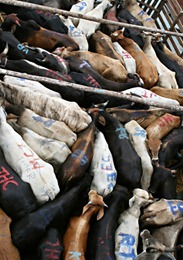It’s Vegetarians Vs Meat Eaters Again
 If the world stopped eating grain-fed meat tomorrow, in short order some 800 million people could be fed on the grain the animals no longer needed. Of course, that’s not going to happen, but it shows that even a small reduction in meat consumption by enough people would have a huge impact. In fact, it’s not the meat, it’s the grain we feed livestock to make them fatter, faster that’s the problem.
If the world stopped eating grain-fed meat tomorrow, in short order some 800 million people could be fed on the grain the animals no longer needed. Of course, that’s not going to happen, but it shows that even a small reduction in meat consumption by enough people would have a huge impact. In fact, it’s not the meat, it’s the grain we feed livestock to make them fatter, faster that’s the problem.
Cattle used to be left alone on the fields to fatten on grass. But now, once cattle are full-grown, they are brought in to feed lots, where they are stuffed with grains to increase their weight before they are slaughtered. Huge quantities of cattle eat huge quantities of grain, and that’s the problem.
We consider meat a major source of protein, but it takes a disproportionate amount of energy to bring it to the dinner table. It takes 54 units of fossil fuel energy to raise the grain and perform all the other operations required to provide 1 unit of protein. Chickens come out a lot better: for poultry, the ratio of energy input to protein output is 4:1.
But that would not be the only benefit. When cattle are raised on grass, their manure and their urine falls widely distributed on the fields where cattle graze and fertilizes them. When cattle are fed on feed lots, their manure has to be collected in ponds and processed. In rains and in accidents, the ponds leak and their contents get into the water supply. The nitrates feed algae in the ponds and rivers and contributes to algal blooms and other causes that destroys fish and other aquatic life.
The same is true for poultry. The huge factory farms where thousands of birds are crowded in huge hen houses create the same problems of runoff and water pollution. This is minimized when chickens are brought up outdoors, free-range.
Another benefit is that cattle who are raised on grass and chickens who are raised in yards large enough to have plenty of room are much less likely to be sick and don’t need antibiotics, which are given prophylactically to crowded animals.
But not even grass-fed cattle and free range chickens minimize the amount of water used by the animals we raise for food. Animal agriculture is one of the biggest users of water in the U.S. It takes 100,000 liters of water to raise a kilo of cow. Chickens are much better, water-wise, but a kilo of white meat still requires 3500 liters of water be expended to produce it. Compare that to the 900 liters it takes to produce a kilo of wheat.
Half of the grain raised in the U.S. and nearly 40% of the grain raised in the rest of the world is devoted to satisfying out taste for meat, rather than being directly consumed by people. As more countries transition from Third World toward First World living, their meat consumption rises. Yet, at the same time, food prices are increasing so rapidly that a estimated third of the world’s people are not getting enough food.
Going to grass-fed cattle and free-range chickens are unlikely to solve the problem by letting us eat grain-free meat. As they are more costly per kilo to raise, it is unlikely more than a small segment of farmers will raise them. It looks like the human race will have to consider a more vegetarian diet if it is going to prevail.


